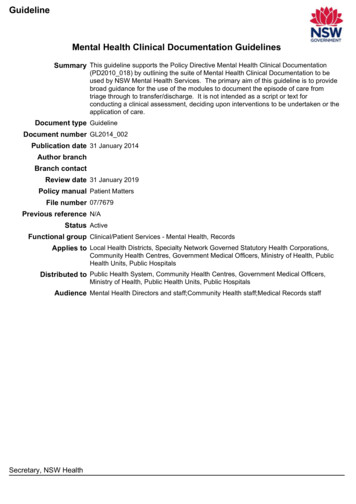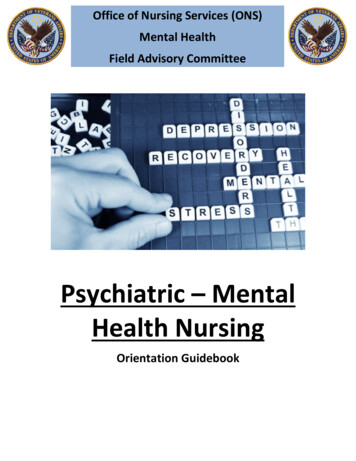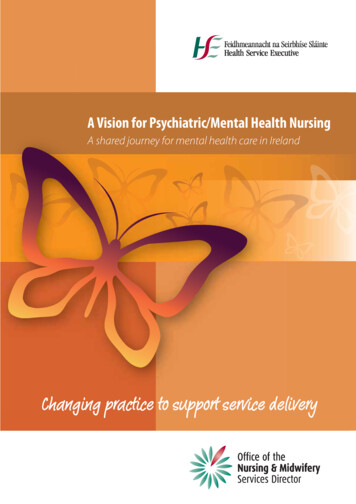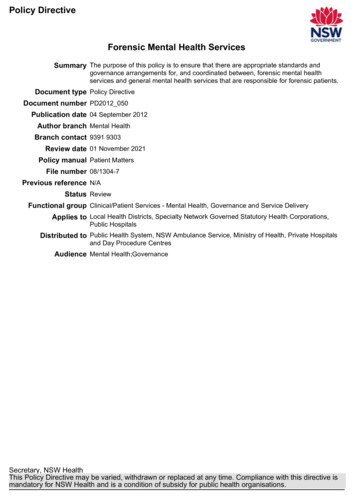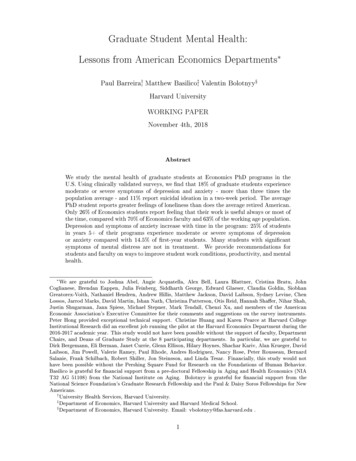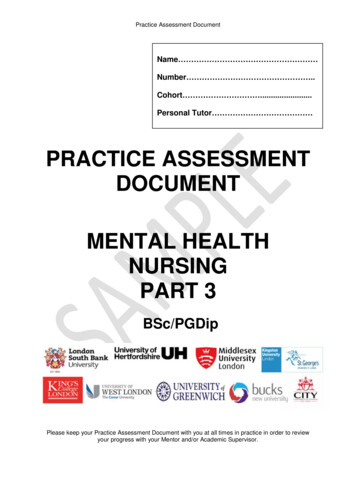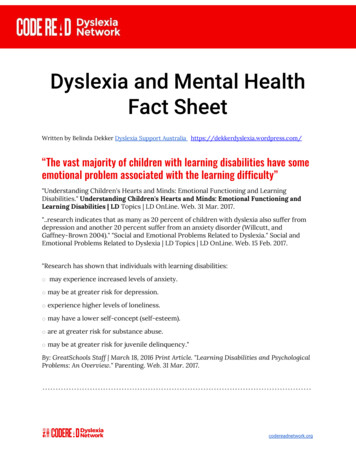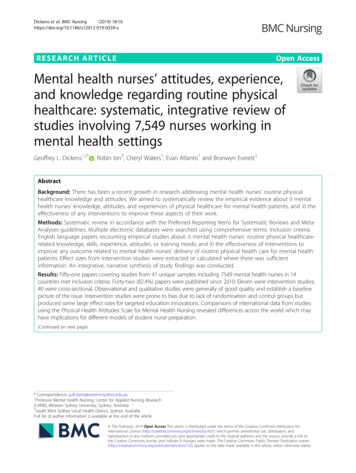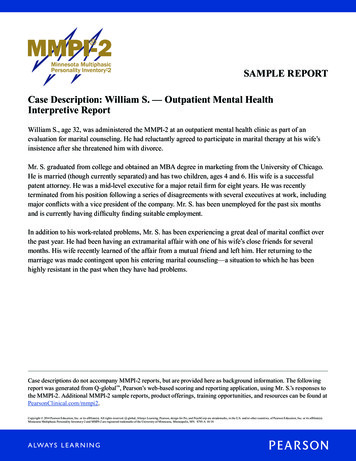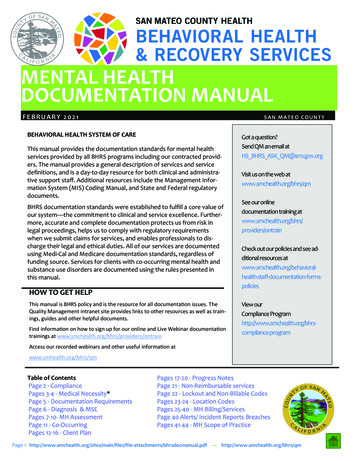
Transcription
MENTAL HEALTHDOCUMENTATION MANUALFEBRUARY 2021SAN MATEO COUNTYBEHAVIORAL HEALTH SYSTEM OF CAREThis manual provides the documentation standards for mental healthservices provided by all BHRS programs including our contracted providers. The manual provides a general description of services and servicedefinitions, and is a day-to-day resource for both clinical and administrative support staff. Additional resources include the Management Information System (MIS) Coding Manual, and State and Federal regulatorydocuments.BHRS documentation standards were established to fulfill a core value ofour system—the commitment to clinical and service excellence. Furthermore, accurate and complete documentation protects us from risk inlegal proceedings, helps us to comply with regulatory requirementswhen we submit claims for services, and enables professionals to discharge their legal and ethical duties. All of our services are documentedusing Medi-Cal and Medicare documentation standards, regardless offunding source. Services for clients with co-occurring mental health andsubstance use disorders are documented using the rules presented inthis manual.HOW TO GET HELPThis manual is BHRS policy and is the resource for all documentation issues. TheQuality Management intranet site provides links to other resources as well as trainings, guides and other helpful documents.Find information on how to sign up for our online and Live Webinar documentationtrainings at www.smchealth.org/bhrs/providers/ontrainGot a question?Send QM an email atHS BHRS ASK QM@smcgov.orgVisit us on the web atwww.smchealth.org/bhrs/qmSee our onlinedocumentation training atwww.smchealth.org/bhrs/providers/ontrainCheck out our policies and see additional resources tation-formspoliciesView ourCompliance gramAccess our recorded webinars and other useful information atwww.smhealth.org/bhrs/qmTable of ContentsPage 2 - CompliancePages 3-4 - Medical Necessity*Page 5 - Documentation RequirementsPage 6 - Diagnosis & MSEPages 7-10- MH AssessmentPage 11 - Co-OccurringPages 12-16 - Client PlanPages 17-20 - Progress NotesPage 21 - Non-Reimbursable servicesPage 22 - Lockout and Non-Billable CodesPages 23-24 - Location CodesPages 25-40 - MH Billing/ServicesPage 40 Alerts/ Incident Reports BreachesPages 41-44 - MH Scope of PracticePage 1 achments/bhrsdocmanual.pdf — http://www.smchealth.org/bhrs/qm
COMPLIANCE ISSUESCOMPLIANCE ISSUESBHRS Policy 91-05 : Compliance withBHRS has adopted a Compliance Plan to express our commitment Documentation Standards is the sourceto providing high-quality health care services in accordance withfor documentation policy in this manual.all applicable federal, state and local rules and regulations. A keycomponent of the Compliance Plan is the assurance that all services submitted for reimbursement arebased on accurate, complete and timely documentation. Read more about the BHRS Compliance Program here: http://www.smchealth.org/bhrs-compliance-program. It is the personal responsibility of allproviders to submit a complete and accurate record of the services they provide, and to document incompliance with applicable laws and regulations. The QM program strives to support the provider network in the provision of quality care, and to maintain programmatic, clinical andfiscal integrity.Every serviceentry shall: Be legible.NOTES MUST BE ACCURATE AND FACTUAL. It is critically important for staff to be Accurately reflectthe activity, locaaware of their essential role in ensuring the compliance of our services with all pertion, and durationtinent laws. The progress note is used to record services that produce claims.of each service.Please keep in mind that when you write a billable progress note, you are submit Use Service Codeting a bill to the State. Notes must be accurate and factual. Errors in documenta55 or 550 for sertion (e.g., using incorrect locations or service charge codes) directly affect our abilvices that are notclaimable (seeity to submit true and accurate claims. For this reason, compliance is the personal“Nonresponsibility of all clinical and administrative staff at BHRS.ReimbursableActivities. Be signed legiblywith your discipline, or signed inthe electronicmedical record.To ensure compliance, documentation for all servicesprovided must observe the following overarchingrules:without a current assessmentmay not be submitted for reimbursement.Progress notes completed more than 30 days (forMH) after the service date are considered excessively late and must be coded as non-billable (55/550)unless otherwise approved by BHRS Quality Management.All services must be based ona current client treatment plan that is updated atleast annually for MH (see Client Treatment and Recovery Plan.)The date of a late entry must be clearly identified inthe documentation.Notes must be signed legibly, including your discipline, or signed in the electronic medical recordbased on your password.All services will be based on a current assessmentupdated every 3 years (for MH). All charts must contain an admission assessment and, as indicated, acurrent updated reassessment. Services providedServices provided after the expiration of the client’streatment plan will not be submitted for reimbursement to the State.Services must be provided within the staff person’sscope of practice, as indicated in this manual.Contractors that submit billing or invoices are required to attest that all billing is correct. Contractorsthat submit bills for services that were not providedare subject to fines and/or loss of their contract withSan Mateo County.Please remember that when you write a billable progress note, you are submitting a bill to the State.All services shall be documented as described in this Documentation Manual, and in accordance with anyamending or procedural bulletins, memos, alerts or policies issued prior to or following its adoption.Page 2 achments/bhrsdocmanual.pdf — http://www.smchealth.org/bhrs/qm
MEDICAL NECESSITYMedical Necessity is established by adherence to three primary tests or criteria:1. An Included Diagnosis that is supported by the client’s symptoms, impairments and/or behaviors as documented on the most current Assessment.2. One or more Significant Impairments that have an impact on functioning present (or expected if untreated) that are the direct result of an included diagnosis.3. Interventions proposed (on the Client Plan) and actual interventions provided (documentedin a Progress Note) that address the goals and objectives of the Client Plan. The Interventionsmust be linked to the symptoms/impairments of the client’s diagnosis. If the proposed intervention is not included on the Client Plan, it may not be billed in a Progress Note.DOCUMENTATION OF MEDICAL NECESSITY:Every billed service (other than services solely for the purpose of assessment or crisis intervention) must meetthe test of Medical Necessity. Medical Necessity means: 1) the service is directed towards reducing the effectof symptoms/behaviors of an included diagnosis and its resulting functional impairments or, 2) the service isrendered to prevent an increase in those symptoms/behaviors or functional impairments (prevent deterioration), or to maintain the current level of functioning.Documentation must support ongoing Medical Necessity to ensure that all provided services are Medi-Cal reimbursable. To be reimbursable, all services claimed to Medi-Cal, except for assessment or crisis intervention,MUST fit into the “Clinical Loop” and support Medical Necessity. The “Clinical Loop/Golden Thread” is the sequence of documentation that supports the demonstration of ongoing medical necessity and ensures that allprovided services are Medi-Cal reimbursable.The sequence of documentation on which Medical Necessity requirements converge is as follows:The Assessment - The completion of an Assessment establishes the foundation for an included diagnosis andthe resulting symptoms and impairments in life functioning.The Client Treatment & Recovery Plan - The demonstration of Medical Necessity is carried forward into theClient Treatment & Recovery Plan, where the diagnosis and its symptoms/impairments are used to establishtreatment goals/objectives and the proposed clinical interventions that will address the identified objectives.The Progress Note - Progress Notes document delivered services that are linked to an intervention identifiedon the Client Treatment & Recovery Plan. Progress Notes document progress the client is making toward theirobjectives.The Clinical Loop is not a one-time activity. The Clinical Loop occurs throughout the client’s treatment andshould be reviewed and updated on a regular basis to ensure that interventions are consistent with currentsymptoms/impairments and behaviors documented in the Clinical Record. Document all elements of MedicalNecessity in the Progress Note. There should be sufficient documentation in the Clinical Record to support theinterventions recorded in the Progress Note.Page 3 achments/bhrsdocmanual.pdf — http://www.smchealth.org/bhrs/qm
MEDICAL NECESSITYMEDICAL NECESSITYOutpatient/Specialty Mental Health Services and SUD/ODS Services must meetall 3 of the following criteria for Medical Necessity (diagnostic, impairment &intervention-related) to be Medi-Cal reimbursable.A. DIAGNOSTIC CRITERIA: The focus of the service should be directed to theclient’s functional impairments and related to an Included Diagnosis.The primary diagnosis must be an included one (*See link below). When a mental health diagnosis and a substance use/abuse diagnosis are both present, themental health diagnosis must be the primary diagnosis. A primary provisional,deferred or rule-out diagnosis must be confirmed or changed within two (2)months of opening the case.NOTE:If the client does nothave an includedmental health diagnosis,the program supervisoris required to informBHRS QualityManagementHS BHRS ASK QM@smcgov.org to block Medi-Calbilling.B. IMPAIRMENT CRITERIA: The client must have at least one (1) of the following as a result of mental health disorder(s) or emotional disorder identified inthe diagnostic criteria (A):1.A significant impairment in an important area of life functioning, or2. The probability of significant deterioration in an important area of life functioning, or3. Children qualify if there is a probability the child will not progress developmentally as individually appropriate, or4. For full scope Medi-Cal clients under the age of 21, a condition as a result ofthe mental disorder or emotional disturbance that SMHS can correct orameliorate.C. INTERVENTION RELATED CRITERIA: The proposed and actualintervention(s) will do at least one (1) of the following:1. Significantly diminish the impairment,2. Prevent significant deterioration in an important area of life functioning,3. Allow the child to progress developmentally individually as appropriate.4. For full-scope MC clients under the age of 21, ameliorate the condition.MH Medi-Cal clients withan included diagnosis anda substance-relateddisorder may receivespecialty mental healthservices directed at thesubstance abusecomponent. However, theintervention must beconsistent with, andnecessary to, theattainment of the specialtymental health treatmentgoals linked to theprimary, included mentalhealth diagnosis.LIST OF INCLUDED DIAGNOSES Mental file-attachments/billabledx-enclosures 2 in 18-053 icd-10.pdf?1563303359Selecting Correct Diagnosis in Avatar, with list of included r.pdf?1559748212Page 4 achments/bhrsdocmanual.pdf — http://www.smchealth.org/bhrs/qm
DOCUMENTATION REQUIREMENTSREQUIREMENTS OVERVIEWTo avoid disallowance of a service, a chart must have all of the following items completed ontime : Initial Assessment completed within 60 days of the Intake Date. Initial Client Treatment and Recovery Plan completed within 60 days of the Intake Date. Most programs will complete assessment and treatment within the first few service appointments . Planned services cannot be provided until an assessment and treatment planare completed and signed by LPHA (*See pp. 28-29 for Planned Services). Re-Assessment completed every 3 years, or sooner if there is a significant change. Client Treatment and Recovery Plan updated annually by the due date.Timelines are mandated and fixed for each client.Assessments and Client Treatment & Recovery Plans may be amended with additional materialadded at any time. These subsequent changes do not alter the established timelines in Avatar.ASSESSMENT SERVICE STRATEGIES - Broad categoers and sites offering social services.ries describing an underlying concept or fundamenDelivered in Partnership with Substance Abuse Sertal approach by a team or program. A service stratevices – Services integrated or coordinated with subgy will be checked as part of a client’s Assessmentstance abuse services, including co-location or colwhen it is anticipated to be a part of the core serviceslaboration with providers and sites offering subprovided to the client.stance abuse services. (Does not include substancePeer/Family Delivered – Services provided by clientsabuse services provided by County staff.)and family members hired as program staff.Integrated Services for MH & Aging – Services intePsycho-Education – Services providing education regrated or coordinated with issues related to aging,garding diagnosis, assessment, medication, supincluding co-location or collaboration with providports, and treatments.ers and sites offering aging-related services.Family Support – Services pro
mental health diagnosis must be the primary diagnosis. A primary provisional, deferred or rule-out diagnosis must be confirmed or changed within two (2) months of opening the case. B. IMPAIRMENT CRITERIA: The client must have at least one (1) of the follow-ing as a result of mental health disorder(s) or emotional disorder identified in the diagnostic criteria (A): 1. A significant impairment .
